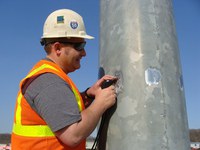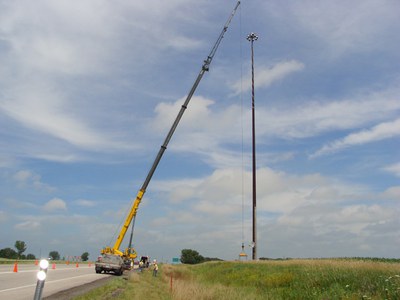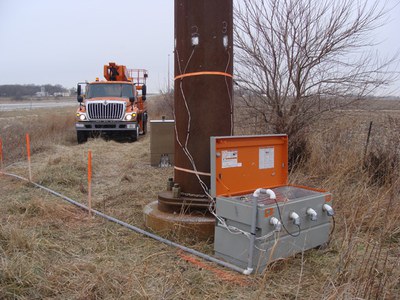Development of Fatigue Loading and Design Methodology for High-Mast Light Poles
|
This research project investigated cyclical, wind-induced loads on high-mast light towers (HMLTs). Field and laboratory tests were performed to investigate the effects of wind gusts (i.e., buffeting), vortex shedding, and associated dynamic oscillations. A long-term field monitoring study gathered wind and strain gage data from eleven different HMLTs over the course of two years. Fourteen additional HMLTs were pluck tested to gather dynamic data. Wind tunnel tests were completed to examine flow separation and wake characteristics of various multi-sided, tapered, tube geometries. Results obtained from the field and laboratory tests lead to the development of rational design criteria to be used for the fatigue design of HMLTs. The concept of a combined wind effect, which accounts for the effects of a variety of wind-induced loads, is presented for fatigue design. In addition, to ensure the fatigue loading is properly implemented into practice, a design methodology and specification with associated commentary was also developed. The field monitoring program was implemented under National Cooperative Highway Research Program (NCHRP) 10-74 to determine the in-service response of high-mast light towers (HMLTs). Prior to the research, loads provided in the AASHTO Standard Specifications for Structural Supports for Highway Signs, Luminaires and Traffic Signals were based on results from NCHRP Report 412, which examined a wide range of support structures and a variety of wind loading phenomena. Report 412 modeled the response of support structures using spectral analysis to simulate natural wind gusts and modal analysis to simulate vortex shedding (Kaczinski et al., 1998). This study was fundamentally different in approach by using field-measured experimental data and focusing only on HMLTs. Eleven HMLTs at eight different sites were included in a long-term field monitoring program to establish the in-service response of these structures. Further, data from two other HMLT monitoring programs in the state of Iowa were also used to support the findings from this study. To estimate the response over the lifetime of the structures, the duration of monitoring lasted up to two years. Height of the HMLTs varied from 100 feet to 160 feet, which represents the majority of the general population. The taper rate of the supporting pole structures was approximately 0.14 inches per foot. (Previous editions of AASHTO Signs assumed this taper rate to be the minimum associated with disrupting the formation of organized vortices and thus preventing the vortex shedding lock-in effect from occurring.) The cross section of all monitored poles was multi-sided with the exception of one circular cross section. The multi-sided poles were 12-sided or 16-sided, dodecagonal or hex decagonal, respectively. These are the most common cross-sections fabricators use for these types of structures. In conjunction with the long-term monitoring, 14 additional HMLTs were tested to determine their dynamic properties. A procedure called “pluck” testing was used to excite the HMLTs dynamically. These HMLTs had similar dimensional and geometric properties as the ones selected for long-term monitoring. |
|





